Palitana temples
The Palitana temples of Jainism are located on Shatrunjaya hill by the city of Palitana in Bhavnagar district, Gujarat, India. The city of the same name, known previously as Padliptapur, has been dubbed "City of Temples". Shatrunjaya means a "place of victory against inner enemies" or "which conquers inner enemies".
| Shri Shatrunjaya Tirtha, Palitana | |
|---|---|
Siddhachal, Vimalgiri, Siddhagiri | |
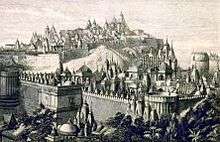 | |
| Religion | |
| Affiliation | Jainism |
| Deity | Rishabhanatha |
| Festivals | Mahavir Janma Kalyanak, Falgun Feri |
| Governing body | Anandji Kalyanji Trust |
| Location | |
| Location | Palitana, Bhavnagar district, Gujarat |
 Location of Palitana Temples in Gujarat | |
| Geographic coordinates | 21°28′58.8″N 71°47′38.4″E |
| Specifications | |
| Temple(s) | 863 |
| Monument(s) | 2700 |
| Elevation | 603 m (1,978 ft)3600 |
| Part of a series on |
| Jainism |
|---|
 |
|
Jain prayers |
|
Ethics |
|
Major sects |
|
Texts |
|
Festivals
|
|
|
This site on Shatrunjaya hill is considered sacred by Svetambara Jains. It is said that 23 of 24 Jain Tirthankaras, except Neminatha, sanctified the hill by their visits. There are approximately 863 marble-carved temples on the hills spread mostly in nine clusters, some being vast temple complexes, while most small in size. The main temple is dedicated to Rishabhanatha, the first Tirthankara; it is the holiest shrine for the Svetambara Murtipujaka sect. The main temple is reached by stepping up 3500 steps. Along with Shikharji in the state of Jharkhand, the two sites are considered the holiest of all pilgrimage places by the Jain community.[1][2] Jains believe that a visit to this group of temples is essential as a once-in-a-lifetime chance to achieve nirvana or salvation.[3]
Of note, Digambara Jains have only one temple here on the hills.[4]
Hingraj Ambikadevi (known as Hinglaj Mata) is considered as the presiding deity of the hill, who is a Jain Yakshini (attendant deity).[5]
Also, on the summit, there is a shrine of a Muslim saint by name Angar Pir who is reported to have protected the temples during Muslim invasions in early 14th century.[7]
As the temple-city was built to be an abode for the divine, no one is allowed to stay overnight, including the priests.[8]
Etymology
Shatrunjaya means a "place of victory against inner enemies" or "which conquers inner enemies".[9] There are 108 names of Shatrunjaya but only some of them are in common use.[10][11]
Geography
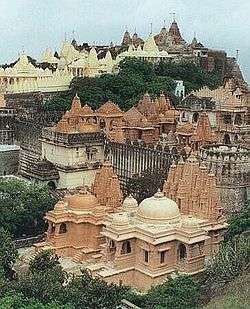
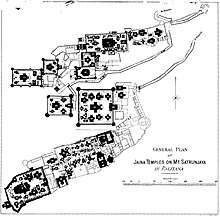
The Gulf of Cambay is to the south of the Shatrunjaya Hills, and Bhavnagar city is to the north of the hills with the Shetrunji River flowing in between.[12] The temple complex on the hills is located 56 kilometres (35 mi) southwest of Bhavnagar.[13] Palitana, a town in the foothill is 2 kilometres (1.2 mi) away. The Palitana town is at an altitude of only 66 m (217 ft). The Palitana Temples are situated at the twin summits and the saddle linking them. The summit is situated at an elevation of 7,288 feet (2,221 m).[9] Reaching it involves climbing over 3,750 stone steps.[14]
The temples remain closed for the devotees during the monsoon season.
- Paths
It takes approximately two hours to make the 3.5 kilometres (2.2 mi) climb.[15] There are multiple routes. The shortest one goes around the outer walls of the temples on the hilltop and passes Angar Pir, the shrine of a Muslim saint who is reported to have protected the temples during Muslim invasions. A second route goes around the foot of the mountain. Elderly pilgrims who cannot climb the stairs are carried on a doli (swing chair) carried by porters and charged based on the pilgrim's weight.[9]
A large number of pilgrims take part in a third route in the month of Phalguna (February/March), which passes five sacred temple sites over a distance of 45 kilometres (28 mi).
- Grounds
From the top of Shatrunjaya are views of the Shetrunji river and the rugged, drought-affected landscape.[9] The narrow streets or lanes in the temple complex are similar to the ones found in the medieval cities of Europe. The high walls surrounding the temples give the appearance of a fort. Important features include the Ashok tree, the Chaitra tree, Jaytaleti, four-faced idol of Mahavir, Hingraj Ambikadevi (known as Hinglaj Mata, the presiding deity of the hill, worshiped by Hindus), Kumarpal, Vimalshah and Samprati.
History
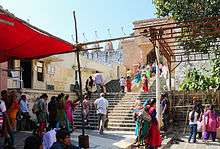
According to the Shatrunjaya Mahatmya, the first Tirthankara Rishabha sanctified the hill where he delivered his first sermon. It was his grandson Pundarika, grandson of Rishabha who attained Nirvana at Shatrunjay, hence the hill was originally known as "Pundarikgiri". There exists a marble image of Pundaraksvami consecrated in V.S. 1064 (1120 CE) by Shersthi Ammeyaka to commemorate the sallekhana of a muni belonging to the Vidhyadhara Kula.[16] Bharata Chakravartin, the father of Pundarik and half-brother of Bahubali, also came to Shatrunjaya many times. He is also credited with building a temple here in honour of his father Rishabha. Legendarily it is also associated with many other Tirthankaras.[upper-alpha 1][18][19][20][21]:249
The Palitana temples were built over a period of 900 years starting in the 11th century.[14] Kumarpal Solanki, a great Jain patron, probably built the earliest temples.It is said that sculptors' skills and capacity to carve with abrasive cords (not tools) the intricate designs was paid on the basis of the marble dust that they had collected every evening after their hard labour. They were destroyed by Turkish Muslims invaders in 1311 AD, when the saint Jinaprabhasuri, who was then 50 years old, presided over the temples. Two years later, the rebuilding began. While some temple building activity took place under Samara Shah, it was only two centuries later that it picked up momentum, when in 1593, Hiravijayasuri (Chief of Tapa Gaccha) organized a major pilgrimage to this location to attend the consecration ceremony of the temple built for Rishabha by Tej Pal Soni, a merchant. Following this, there was proliferation of temples here.[19]
Most of the temples which are now present date to the 16th century. In 1656, Shah Jahan's son Murad Baksh (the then Governor of Gujarat) granted Palitana villages to the prominent Jain merchant Shantidas Jhaveri, a Svetambara Jain. Subsequently, all taxes were also exempted, helping the temple town prosper further. It was brought under the control of the Anandji Kalyanji Trust in 1730 to manage not only Palitana temples but also many other temples of Svetambara Jains, since the Mughal period.[19][22]
History also makes a mention that Lunia Seth Tilokchand, a merchant from Ajmer led a very large contingent of pilgrims to the Shatrunjaya temples when he heard that there were some disturbances at the Angarshah Pir on the hills. But he continued his pilgrimage and pleased the Pir by his offerings. This tradition is followed to this day by his descendants by offering an expensive cloth to cover the dome of the shrine.[23]
The most important temples on the hill are those of Adinath, Kumarpal, Sampratiraja, Vimal Shah, Sahasrakuta, Ashtapada and Chaumukh.[24] Some of them are named after the wealthy patrons who paid for the construction.
Many of these temples are kept in “mint” condition with large donations provided by the rich Jain merchant community.[12]
Palitana was a princely state of India till it merged with India after independence in August 1947.[7] It was the capital of the Kingdom of Rajpipla and Gohil Rajput clan.
Religious practices

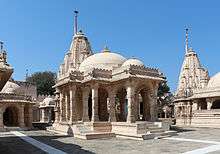

It is inferred that the temples are built in clusters known as tunks, as Jains undertake pilgrimage mostly on foot and hence they would like to reduce the distance of travel on foot to the minimum. As a religious practice they cover their mouth while offering puja to the tirthankaras at the temples so that they don't hurt any insects by swallowing them with an open mouth. Also, for this reason they do not offer open lighted lamps but offer aarti with covered lanterns. The religious practice also involves pilgrimage by fasting throughout the journey to and from the shrines. They also build their temples in white marble to demonstrate purity.[25] Silence and prayers are the order of the day when one is climbing up the hills on pilgrimage.[12] Fasting continues until they have returned to the auditorium of Anandji Kalyanji Trust at the foothill. Eating any food items when on the mountain(Giriraj) is considered to be a sin.[14]
- Renovations
There have been frequent renovations and many of them are dated to the 16th century. New temples continue to be built here.[7] Renovations occurred at least 16 times during the avasarpinikala (the descending half of the wheel of time):[26]
| Renovation | Renovator | Times | Notes |
|---|---|---|---|
| 1st | Bharat Chakravarti | Adinath | son of Adinath |
| 2nd | King Dandavirya | interim period between Adinath and Ajitnath | – |
| 3rd | Ishaneshvar | Indra of Upper World | |
| 4th | Mahendra | Indra of fourth upper world (dev-lok) | |
| 5th | Brahmendra | Indra of fifth upper world (dev-lok) | |
| 6th | Chamarendra | Indra of Bhavanapatis | |
| 7th | Sagar Chakravarti | Ajitnath | second Chakravarti |
| 8th | Vyantarendra | Abhinandannath | – |
| 9th | King Chandrayasha | Chandraprabha | – |
| 10th | Chakrayuddha | Shantinath | son of Shantinath |
| 11th | Ram and Lakshaman | Munisuvrata | Ramayana Kings |
| 12th | 5 Pandava | Neminatha | Mahabharta Kings |
| 13th | Javad Shah of Mahuva | Vikram Samvat 108 | He spent a million gold coins. |
| 14th | advisor Bahud | Vikram Samvat 1213 | Times of Kumarpal |
| 15th | Samara Shah Oswal | Vikram Samvat 1371 | spent 2770000 |
| 16th | Karama Shah of Chitod | Vikram Samvat 1587 | on 6th day of the dark half of Vaisakh |
It is believed that Vimalvahan shall do the 17th renovation during the period of Duppasahsuri in future.[27]
Architecture and fittings
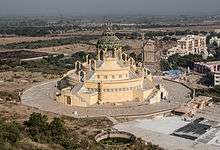
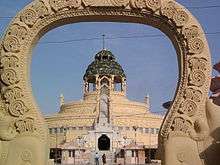
The Palitana temples are considered to be the most sacred tirtha (pilgrimage place) by the Jain community. There are hundreds of temples, with estimates ranging between 863 and 1,008. The larger temples have considerable marble halls with columns and towers, and plenty of openings, unlike Hindu temples. They are situated in separate enclosures, surrounded by high fortified walls. Many of the temples are very small buildings only about 3 square feet (0.28 m2), with Jain emblems, and sacred to Mahavira. The marble floors have tesselated patterns. The interiors are intricately carved, with carved ceilings with geometrical lace designs, clustered together to form a canopy.[9][28] The temples are arranged in systematic groupings with variation in height and space. The buildings are carved in marble and are considered to be prayers in stone. They are grouped in nine separate wings or tuks, each wing having a separate central shrine or temple with minor shrines surrounding it.[24] They have the unique features of the Chaumukh temple which is stated to be their creative preoccupation for large halls for holding discourses. This was prompted by their first tirthanakara's discourse. It is an ensemble involving four sided buildings with doors so that images would be visible from all four sides or directions. The four sides are called the caturbimba (four sided views), which is considered auspicious from all directions. Their religious texts also are oriented towards building "cities of temples" like Palitana and Ranakpur, a particular feature in Jainism.[29]

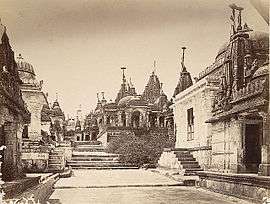
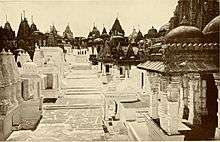
The Adinath temple, which venerates Rishabha, is the main temple (in the apex of the northern ridge of the complex[30]) in the complex and is the grandest. It has ornate architectural motifs, though in its overall plan, it is simpler than the Chaumukh temple. The jewellery collection of this temple is large, which can be seen with special permission from the Anandji Kalyanji Trust. The prayer halls of this temple (renovated in 1157 by Vagabhatta) is decorated with ornamental friezes of dragons.[30] There are stairs from the quadrangle surrounding the temple which lead to a balcony from where one gets a scenic view of the temple complex. There are a series of domes with high spires, 1245 pitchers, 21 images of brightly coloured lions, four yoginis, ten digpals (guards), 72 devkulikas, 32 dolls and 32 toranas. There are three pradakshina routes, followed in a clockwise direction, which are associated with this temple. The first is circular and includes the Sahasrakuta temple, the foot-idols under the Rayan tree, the temple of idols of feet of Ganadhar, and the temple of Simandhar Swami. The second passage passes the new Adishwar temple, Mt. Meru, the temple of Samavasaran temple, and Sammet Shikhar temple. The third passage passes the Ashtapada temple, the Chaumukh temple.[30]

The Adishvara Temple, dated to the 16th century, has an ornamented spire; its main image is that of Rishabha. The Chaumukh temple, built in 1616, has a four-faced Adinatha image deified on a white pedestal, each face turned towards the cardinal directions. Vimal Shah temple is a square structure with towers. Saraswati devi temple, Narsinh Kesharji temple, and the Samavasaran temple, with 108 life-sketches in sculpture, are also notable.
A modern temple, Samvatsarana, was built at the base of the hills of the main temple complex.[9]
In the shrines, on a pedestal, are large figures of Mahavira, sitting with feet crossed in front, like those of Buddha, often decorated with gems, gold plates, and silver.[28] The Adinath temple has an image 2.16 metres (7 ft 1 in) in height of a white-colored idol in the Padmasana posture. The main iconic image of Adinath, carved in fine piece of marble, has crystal eyes. Devotees offer flowers and sandal paste to the deity as they approach the statue for worship. The quadrangle opposite in front of the temples is elaborately designed. There is another shrine opposite to Adishwara temple where the Hindu saint Pundrick Swamy lived in the 5th century.[14] After visiting Adishwara, a temple similar in design, Dilwara temple, is located to the right of the steps used for descending from the main shrine, which is also very elegantly designed with architectural piece in marble. In this temple, Suparswanatha is carved in the centre of a cube-shaped column; Adinatha and Parswanatha adorn the top and bottom of the column. Carvings on the ceiling, floor and the column are very elegantly sculpted. Parswanatha Temple is located in front of this temple.[14]
In 2016, a 108 feet idol of Adinath(Rishabhnatha) was installed.[31][32]
Culture
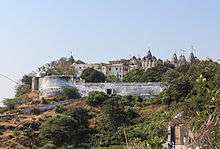
- Beliefs
Every devout Jain aspires to climb to the top of the mountain at least once in his lifetime because of its sanctity to attain nirvana. The code for the climbers is stringent, in keeping with the rigours of the Jain faith. Food must neither be eaten nor carried on the way. The descent must begin before it is evening, for no soul can remain atop the sacred mountain during the night. The Shatrunjaya hills are considered by many Jains to be more important than the temple-covered hills of Jharkhand, Mount Abu and Girnar.[14]
- Festivals
On one special day (Fagun Sud 13), which commonly falls in February/March, thousands of Jain followers visit the temple complex to attain salvation. Three times as many pilgrims come at this time, which is also called "6 Gaon".[33] The special festival day is the "Chha Gau Teerth Yatra" at the temple complex held on Purnima day (Full Moon Day) of Kartika month according to the Jain calendar, Vira Nirvana Samvat (October–November as per the Gregorian Calendar). Jains, in very large numbers assemble on this day at the temple complex on the hills as it opens after 4 months of closure during the monsoon season. During this pilgrimage, considered a great event in the lifetime of devout Jain, pilgrims circumambulate the Shatunitjaya Hills covering a distance of 21.6 km on foot to offer prayers to Adinatha on the Kartik Poornima Day at the top of the hill.[13]
Mahavir Janma Kalyanak, the birthday of Mahāvīra, is a notable festival celebrated at the temple complex. A procession carrying images of the tirthankara is made in huge decorated chariots, concurrently accompanied by religious ceremonies in the temples. Rituals include fasting and giving alms to the poor.[7]
Gallery
.jpg) Adishwar Temple
Adishwar Temple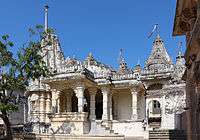 A temple in Palitana temples complex
A temple in Palitana temples complex Mata Padmavati Mandir
Mata Padmavati Mandir Palitana temples complex
Palitana temples complex Palitana temples complex
Palitana temples complex- Palitana Temples distant view
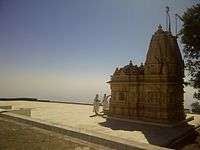 Derasar on top Shri Shatrunjaya
Derasar on top Shri Shatrunjaya View from Motisha Tonk
View from Motisha Tonk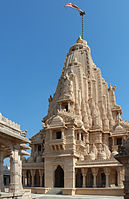 Temple Inside Chaumukhji Tonk
Temple Inside Chaumukhji Tonk
See also
| Wikimedia Commons has media related to Palitana temples. |
Notes
- Bharata installed 24 life-size idols of all 24 Tirthankaras along with an image of himself and his 99 brothers. The location of this temple is unclear and it is believed that he hide the temple from unworthy. In early Jain Literature, such as the Āvaśyaka Niryukti, gāthā 435, it is identified as Mount Ashtapada, a mythical mountain in Himalayas. Hemchandra identified it with Shetrunjaya. Ashtapada is frequently identified with Mount Kailash now.[17]:15, 97
References
Citations
- "Murtipujakas, Jainism", Encyclopedia of World Religions (PHILTAR), University of Cambria Archived 13 October 2007 at the Wayback Machine
- John E. Cort, Framing the Jina: Narratives of Icons and Idols in Jain History, p.120. Oxford University Press (2010). ISBN 0-19-538502-0
- Melton 2011, p. 19.
- Peter 2010, p. 352.
- Suriji 2013, p. 31.
- Desai 2007, p. 247.
- "Palitana Temples". Government of Gujarat.
- Arnett 2006, pp. 164-165.
- Shetrunjay Giriraj Aaaradhana, p. 77.
- Suriji 2013, p. 11.
- Bruyn et al. 2010, p. 597.
- Pilgrims flock Palitana for Kartik Poornima yatra.
- Glistening spires of Palitana temples.
- Taylor 2011, p. 301.
- Some Inscriptions and Images on Mount Satrunjaya, Ambalal P Shah, Mahavir Jain Vidyalay Suvarna Mahotsav Granth Part 1 01 2002, p. 164
- Shah 1987.
- Davidson & Gitlitz 2002, p. 419.
- Dundas 2002, p. 222.
- Ku 2011, pp. 1-22.
- Weber, Albrecht F. Über das Çatrumjaya Māhātmyam. Ein Beitrag zur Geschichte der Jaina. Abhandlungen für die Kunde des Morgenlandes herausgegeben von der Deutschen Morgenländischen Gesellschaft, I. Band, No. 4. Leipzig: F. A. Brockhaus, 1858 (Translated as "The Śatruñjaya Māhātmyam. Edited by James Burgess." Indian Antiquary30 [1901] 239-251, 288-308)
- Yashwant K. Malaiya. "Shatrunjaya-Palitana Tirtha". Retrieved 28 November 2011.
- Lodha 2013, p. 479.
- Bansal 2005, p. 102.
- Deshpande 2005, pp. 418–420.
- Shetrunjay Giriraj Aaaradhana, pp. 3-5.
- Shetrunjay Giriraj Aaaradhana, pp. 25-27.
- Bettany 1890, p. 340.
- Pereira 1977, p. 16.
- Deshpande 2005, pp. 418–419.
- Palitana 108 feet high statue of Adinath dada.
- http://www.palitanaonline.com/jambudweep/108.php
- "6 Gaon Yatra" (PDF). jainuniversity.org.
Sources
- Deshpande, Aruna (2005), "India:Divine Destination", Palitana, Crest Publishing House, pp. 418–419, ISBN 81-242-0556-6
- Suriji, Acharya Gunaratna (2013), A Visit to Shatrunjaya: Journey to the holiest pilgrimage of Jainism, Multy Graphics, ISBN 9788192660707, retrieved 2 October 2017
- Bruyn, Pippa de; Bain, Keith; Allardice, David; Joshi, Shonar (2010), Frommer's India, John Wiley & Sons, ISBN 978-0-470-64580-2, retrieved 20 December 2012
- Melton, J. Gordon (2011), Religious Celebrations: An Encyclopedia of Holidays, Festivals, Solemn Observances, and Spiritual Commemorations: An Encyclopedia of Holidays, Festivals, Solemn Observances, and Spiritual Commemorations, ABC-CLIO, ISBN 978-1-59884-205-0, retrieved 21 December 2012
- Peter, Berger (2010), The Anthropology of Values: Essays in Honour of Georg Pfeffer, Pearson Education India, ISBN 978-81-317-2820-8, retrieved 21 December 2012
- Singh, Sarina; Benanav, Michael; Blasi, Abigail; Clammer, Paul; Elliott, Mark; Harding, Paul; Mahapatra, Anirban; Noble, John; Raub, Kevin (2015), Lonely Planet India, Lonely Planet, ISBN 9781743609750
- Shetrunjay Giriraj Aaaradhana (PDF) (in Gujarati), Surat: Roop Nakoda Cheritable Trust, pp. 77, 3–5, 25–27
- Arnett, Robert (2006), India Unveiled, Atman Press, ISBN 978-0-9652900-4-3, retrieved 17 December 2012
- Taylor, Max T. (2011), Many Lives, One Lifespan: An Autobiography, Xlibris Corporation, ISBN 978-1-4628-8799-6, retrieved 17 December 2012
- Desai, Anjali H. (2007), India Guide Gujarat, India Guide Publications, ISBN 978-0-9789517-0-2
- Dundas, Paul (2002), The Jains, Psychology Press, ISBN 9780415266055
- Shah, Umakant Premanand (1987), Jaina-rūpa-maṇḍana: Jaina iconography, Abhinav Publications, ISBN 81-7017-208-X
- Davidson, Dr Linda Kay; Gitlitz, David Martin (2002), Pilgrimage: From the Ganges to Graceland : An Encyclopedia, ABC-CLIO, ISBN 978-1-57607-004-8, retrieved 17 December 2012
- "Pilgrims flock Palitana for Kartik Poornima yatra". The Times of India. 2 November 2009. Retrieved 3 November 2009.
- R. Krishnamurthy (4 June 2006). "Glistening spires of Palitana temples". The Hindu. Hindua. Retrieved 17 December 2012.
- Bettany, George Thomas (1890), The world's religions: a popular account of religions ancient and modern, including those of uncivilised races, Chaldaeans, Greeks, Egyptions, Romans; Confucianism, Taoism, Hinduism, Buddhism, Zoroastrianism, Mohammedanism, and a sketch of the history of Judaism and Christianity (Public domain ed.), Ward, Lock, retrieved 17 December 2012
- Ku, Hawon (2011). "Temples and Petrons: The Nineteenth-century Temple of Motisha at Shatrunjaya" (PDF). International Journal of Jaina Studies (Online). 7 (2).
- Lodha, Jain Chanchalmal (2013), History of Oswals, Panchshil Publications, ISBN 978-81-923730-2-7
- Bansal, Sunita Pant (2005), Enclopaedia of India, Smriti Books, ISBN 978-81-87967-71-2, retrieved 17 December 2012
- Pereira, Jose (1977), Monolithic Jinas The Iconography Of The Jain Temples Of Ellora, Motilal Banarsidass, ISBN 978-81-208-2397-6, retrieved 17 December 2012
- "Palitana 108 feet high statue of Adinath dada". Dainik Bhaskar. Retrieved 11 March 2017.
Further reading
- John E. Cort, Framing the Jina: Narratives of Icons and Idols in Jain History, Oxford U Press (2010). ISBN 0-19-538502-0
